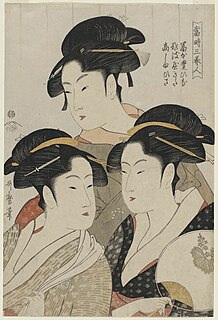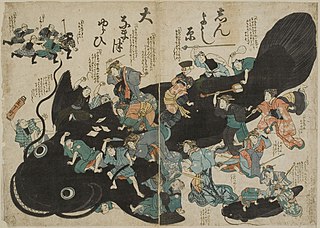 W
WThe term aizuri-e usually refers to Japanese woodblock prints that are printed entirely or predominantly in blue. When a second color is used, it is usually red. Even if only a single type of blue ink was used, variations in lightness and darkness (value) could be achieved by superimposing multiple printings of parts of the design or by the application of a gradation of ink to the wooden printing block (bokashi).
 W
WBijin-ga is a generic term for pictures of beautiful women (bijin) in Japanese art, especially in woodblock printing of the ukiyo-e genre.
 W
WE-hon or Ehon (絵本) is the Japanese term for picture books. It may be applied in the general sense, or may refer specifically to a type of woodblock printed illustrated volume published in the Edo period.
 W
WJoge-e (上下絵) are special playful images that were often created in the Meiji era in Japan. These images can be viewed from the top, or the bottom. Each viewing angle enables the viewer to see a different image.
 W
WKomochi-e (子持絵) or trick pictures are Japanese prints with movable printed paper flaps or other moveable parts. Multicolor komochi-e may be called “komochi nishiki-e” (子持錦絵).
 W
WIn Japanese art, a megane-e is a print designed using graphical perspective techniques and viewed through a convex lens to produce a three-dimensional effect. The term derives from the French vue d'optique. The device used to view them was called an Oranda megane or nozoki megane, and the pictures were also known as karakuri-e.
 W
WMusha-e (武者絵) is a type a Japanese art that was developed in the late 18th century. It is a genre of the ukiyo-e woodblock printing technique, and represents images of warriors and samurai from Japanese history and mythology.
 W
WMuzan-e (無残絵), also known as "Bloody Prints", refers to Japanese woodcut prints of violent nature published in the late Edo and Meiji periods.
 W
WIn Japanese mythology, the Namazu or Ōnamazu is a giant underground catfish who causes earthquakes.
 W
WNishiki-e is a type of Japanese multi-coloured woodblock printing; the technique is used primarily in ukiyo-e. It was invented in the 1760s, and perfected and popularized by the printmaker Suzuki Harunobu, who produced many nishiki-e prints between 1765 and his death five years later.
 W
WShin-hanga was an art movement in early 20th-century Japan, during the Taishō and Shōwa periods, that revitalized traditional ukiyo-e art rooted in the Edo and Meiji periods. It maintained the traditional ukiyo-e collaborative system where the artist, carver, printer, and publisher engaged in division of labor, as opposed to the parallel sōsaku-hanga movement which advocated the principles of "self-drawn" (jiga), "self-carved" (jikoku) and "self-printed" (jizuri), according to which the artist, with the desire of expressing the self, is the sole creator of art.
 W
WShini-e , also called "death pictures" or "death portraits", are Japanese woodblock prints, particularly those done in the ukiyo-e style popular through the Edo period (1603–1867) and into the beginnings of the 20th century
 W
WShunga (春画) is a type of Japanese erotic art typically executed as a kind of ukiyo-e, often in woodblock print format. While rare, there are also extant erotic painted handscrolls which predate ukiyo-e. Translated literally, the Japanese word shunga means picture of spring; "spring" is a common euphemism for sex.
 W
WSōsaku-hanga was an art movement of woodblock printing which was conceived in early 20th-century Japan. It stressed the artist as the sole creator motivated by a desire for self-expression, and advocated principles of art that is "self-drawn", "self-carved" and "self-printed". As opposed to the parallel shin-hanga movement that maintained the traditional ukiyo-e collaborative system where the artist, carver, printer, and publisher engaged in division of labor, creative print artists distinguished themselves as creators of art for art's sake.
 W
WSurimono (摺物) are a genre of Japanese woodblock print. They were privately commissioned for special occasions such as the New Year. Surimono literally means "printed thing". Being produced in small numbers for a mostly educated audience of literati, surimono were often more experimental in subject matter and treatment, and extravagant in printing technique, than commercial prints. They were most popular from the 1790s to the 1830s, and many leading artists produced them. One of the most famous woodblock artists who got his start from producing surimono was Suzuki Harunobu, credited with being the genius behind the later introduction of Nishiki-e.
 W
WUchiwa-e (団扇絵) are a genre of Japanese ukiyo-e woodblock print, which appear on rigid, paddle-shaped hand fans known as uchiwa (団扇). Ovoid images matching the outline of uchiwa were printed on rectangular sheets of washi rice paper, then cut along the margins and pasted onto a skeletal bamboo frame.
 W
WUki-e refers to a genre of ukiyo-e pictures that employs western conventions of linear perspective. Although they never constituted more than a minor genre, pictures in perspective were drawn and printed by Japanese artists from their introduction in the late 1730s through to the mid-nineteenth century.
 W
WUrushi-e refers to three different techniques in Japanese art. Though urushi-e is most associated with woodblock, the term urushi-e is not exclusive to that medium. It can also refer to pictures using lacquer as a paint on three-dimensional lacquered objects; and paintings using actual lacquer on paper or occasionally silk.
 W
WYakusha-e (役者絵), often referred to as "actor prints" in English, are Japanese woodblock prints or, rarely, paintings, of kabuki actors, particularly those done in the ukiyo-e style popular through the Edo period (1603–1867) and into the beginnings of the 20th century. Most strictly, the term yakusha-e refers solely to portraits of individual artists. However, prints of kabuki scenes and of other elements of the world of the theater are very closely related, and were more often than not produced and sold alongside portraits.